Foraging Guides
Can You Forage in State Parks? The Ultimate Guide!
You're just a step away from uncovering the secrets of foraging in state parks, but first, know the rules to avoid getting into trouble.
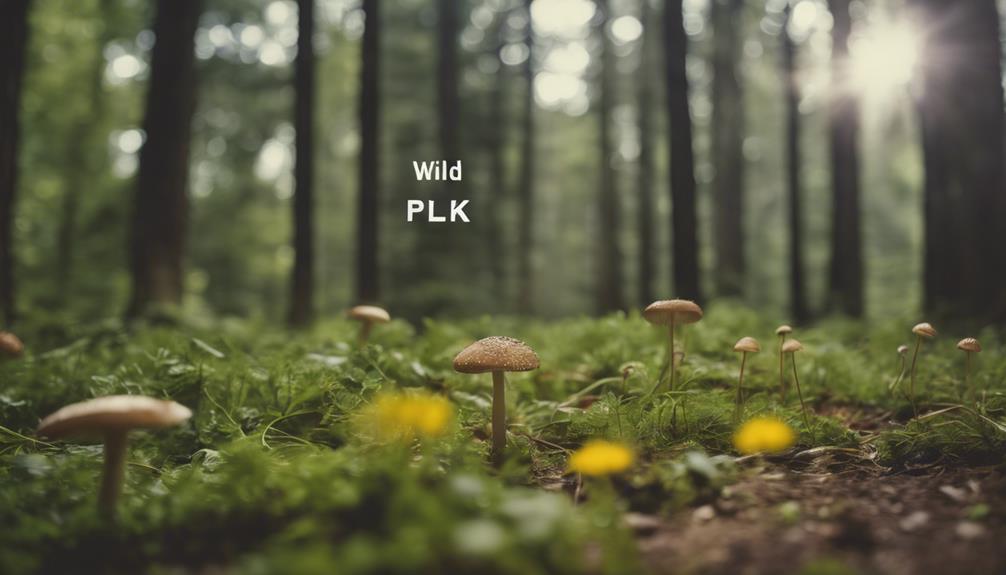
You can forage for wild edibles in state parks, but it's important to understand that regulations vary widely across parks, with some allowing limited foraging for personal use and others requiring permits or having specific restrictions in place. Checking specific rules and restrictions is essential, as trespassing on private property can lead to legal issues. Familiarizing yourself with park boundaries and obtaining permission for accessing private property is key. By understanding state park regulations and following sustainable foraging practices, you can enjoy the thrill of foraging while preserving the environment – and there's more to discover when you venture further.
Key Takeaways
- Regulations for foraging in state parks vary widely, and checking specific rules and restrictions is vital before foraging.
- Some state parks allow limited foraging for personal use, but permits may be required, and following park rangers' instructions is crucial.
- It is essential to understand the regulations before foraging in state parks, as national parks have different rules and guided walks focus on plant identification.
- Respecting private property boundaries is key, as not all lands within state parks are publicly accessible, and trespassing can lead to legal issues.
- Foraging in state parks requires careful attention to plant identification, sustainable practices, and adherence to harvest seasons and conservation efforts.
Understanding State Park Regulations
Prior to heading out to forage in a state park, it's important to familiarize yourself with the specific regulations governing foraging activities within that park. You wouldn't want to get in trouble for picking a wild berry or two without permission! State park regulations on foraging vary widely, with some parks allowing limited foraging for personal use, while others prohibit it entirely.
It's vital to check the specific rules and restrictions of each state park before engaging in any foraging activities. Some state parks may require permits for foraging, so make sure you're aware of any requirements beforehand. Remember, it's always better to err on the side of caution and respect the rules and regulations in place. By doing so, you'll not only avoid any potential trouble but also ensure the park's ecosystem remains protected for future generations.
Always follow the instructions of park rangers and take the time to understand the regulations governing foraging in the state park you plan to visit.
Identifying Edible Plants Safely
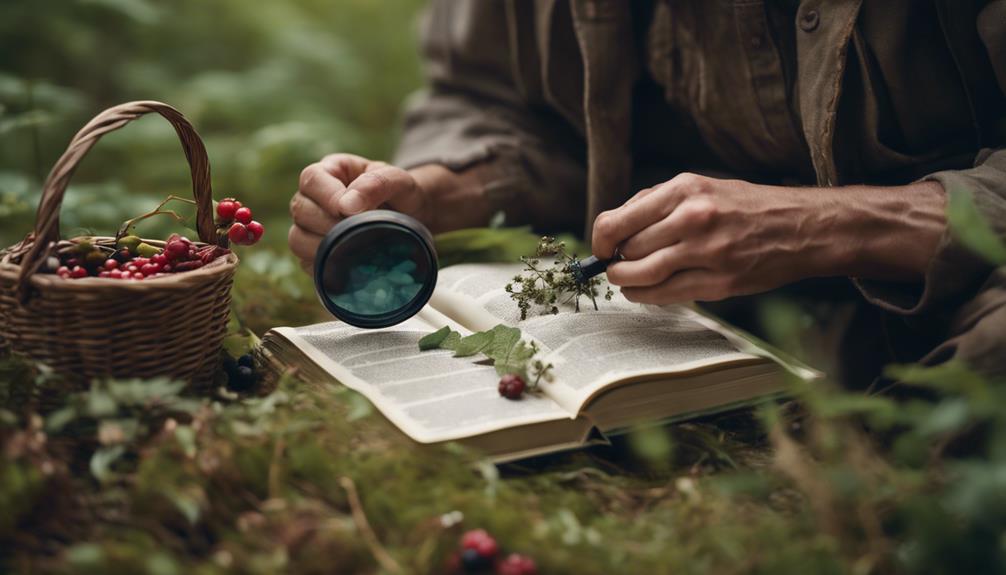
As you prepare to forage in state parks, it's important to shift your focus from understanding regulations to identifying edible plants safely, a task that demands careful attention to detail and dedication to accurate identification.
You'll need to study the characteristics, growth patterns, and common lookalikes of wild plants to make sure you're picking edibles, not toxic ones. Reputable field guides, online resources, and foraging classes can enhance your plant identification skills.
Look for key features like leaf shape, color, arrangement, and any distinct markings to differentiate edible plants from toxic ones. Pay attention to plant habitats, seasonal variations, and growth stages to accurately identify edible plants in the wild.
When in doubt, consult with experienced foragers, botanists, or local experts to confirm the safety and edibility of wild plants. By mastering these foraging techniques, you'll be able to identify edibles with confidence and enjoy the fruits of your labor.
Sustainable Foraging Practices Matter

As you venture into state parks for foraging, remember that sustainable practices are essential to preserving the natural balance.
You play an important role in maintaining the ecosystem's harmony by adopting mindful harvesting techniques and respecting the land.
Respect the Land
By venturing into state parks, you're not only a forager, but also a temporary steward of the land, responsible for preserving its natural beauty and ecological balance.
As you explore, remember that respecting the land is essential. This means avoiding private property and adhering to regulations surrounding foraging in state parks. When foraging, stick to designated trails and areas to minimize your impact on the environment.
Be mindful of the plants you're collecting, making sure you're not over-foraging, which can disrupt the delicate balance of plant populations and harm the ecosystem.
Leave no trace by avoiding damage to plants, soil, and wildlife habitats. This will help preserve the natural resources for future generations.
Remember, respecting the environment is key to sustainable foraging. By following these guidelines, you'll not only guarantee the longevity of the ecosystem but also ensure a continued foraging experience in state parks.
Mindful Harvesting
When you forage in state parks, you're not just collecting wild edibles, you're also making a conscious decision to preserve the delicate balance of the ecosystem. By practicing mindful harvesting, you're ensuring the long-term health of the environment. This means adopting sustainable foraging practices that prioritize responsible and ethical guidelines.
Here are some key principles to keep in mind:
- Take only what you need, leaving enough for wildlife and future foragers.
- Avoid over-harvesting, respecting plant life cycles and avoiding damage to the ecosystem.
- Be aware of regulations and respect protected areas, ensuring the preservation of natural resources.
State Park Ecosystems and Habitats

You'll find that state parks in the US encompass an astonishing array of ecosystems, from lush forests to fragile wetlands, arid deserts, and scenic coastlines. As you explore these diverse ecosystems, you'll discover an incredible variety of habitats, each supporting a unique array of plant and animal species.
Foragers in the South, for instance, can find an abundance of edible plants, from wild berries to medicinal herbs, in the region's humid subtropical forests. When foraging in state parks, you'll encounter protected species, too, like the endangered gopher tortoise, which calls Florida's scrub habitats home.
As you wander through these ecosystems, keep in mind that each park has its own unique flora and fauna, shaped by local climate, soil, and geography. This diversity creates a rich foraging experience, with opportunities to discover new edible delights around every corner.
From the towering trees of the Pacific Northwest to the sun-baked dunes of the Southwest, state parks offer an unparalleled opportunity to explore and learn about the natural world.
Respecting Private Property Boundaries

As you venture into state parks to forage, it's important to recognize that not all lands within the park's boundaries are publicly accessible, and respecting private property boundaries becomes a key aspect of responsible foraging.
You must be aware that some areas within the park may be privately owned, and trespassing can lead to legal issues.
To avoid any problems, follow these guidelines:
- Stay on designated trails and avoid crossing into private property while foraging in state parks.
- Familiarize yourself with park maps and boundaries to make sure you stay within public land while foraging.
- Always obtain permission from landowners if you need to cross private property to access state park foraging areas.
National Park Foraging Restrictions
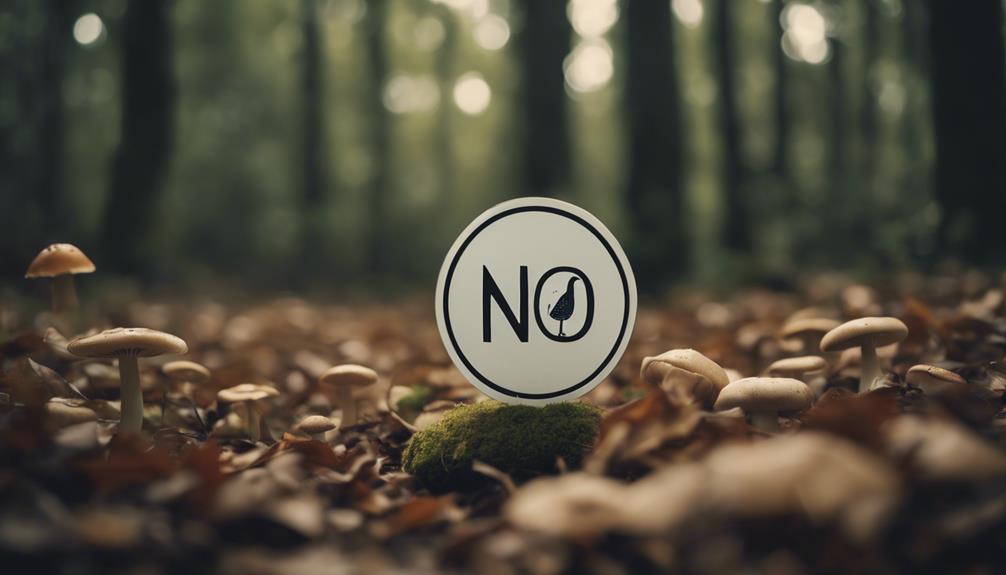
When you plan to forage in a National Park, you'll need to familiarize yourself with federal regulations that apply to these protected areas.
You may find that some parks require permits for collecting wild edibles, so it's crucial to research the specific rules for the park you'll be visiting.
Federal Regulations Apply
Federal regulations strictly prohibit foraging in national parks, prioritizing the preservation of delicate ecosystems over individual desires to gather wild edibles. You might be surprised to learn that even picking wildflowers is off-limits in these protected areas. The regulations regarding foraging in national parks are in place to prevent damage to plant populations and maintain the natural balance of the ecosystem.
Here are some key points to keep in mind:
- Federal regulations take precedence over individual desires to forage for wild edibles in national parks.
- Some national parks may allow limited collection of wild edibles for personal use, but these instances are rare and heavily regulated.
- It's important to research and understand the specific rules and restrictions regarding foraging in national parks before attempting to gather any wild edibles.
Permits Often Required
You may need to obtain a permit before foraging in state parks, as many of them have specific regulations in place to guarantee the conservation of their natural resources. These regulations vary from park to park, so it's important to research the policies of the state park you plan to visit. Some parks may allow limited foraging for personal use with the proper permits, while others may prohibit it altogether.
| Park Type | Permit Required | Foraging Allowed |
|---|---|---|
| National Parks | Yes | No |
| State Parks | Maybe | Limited |
| Guided Walks | No | No |
In national parks, guided walks focus on plant identification rather than foraging. Remember, it's crucial to understand the regulations and permissions for foraging in state parks. Always research the park's policies before heading out to forage. Don't assume that what's allowed in one park is allowed in another. By doing your due diligence, you can ensure a safe and enjoyable foraging experience while preserving the natural beauty of our state parks.
Regional Foraging Guides and Maps

Regional foraging guides and maps are essential tools that provide valuable insights into the diverse ecosystems within state parks, empowering you to plan your trips and identify safe and legal foraging spots. These resources offer detailed information on edible plants, foraging regulations, and sustainable practices, guaranteeing you're well-prepared for your foraging adventure.
By using regional foraging guides and maps, you can:
- Identify areas with an abundance of edible plants, such as berry patches or mushroom hotspots
- Understand local regulations and permits required for foraging in specific state parks
- Learn about sustainable practices to secure the long-term health of the ecosystems you're foraging in
With these guides and maps, you'll be able to explore the natural bounty of state parks while adhering to local laws and sustainable practices. By doing so, you'll not only enjoy a successful foraging trip but also contribute to the conservation of these precious natural resources.
Harvest Seasons and Conservation
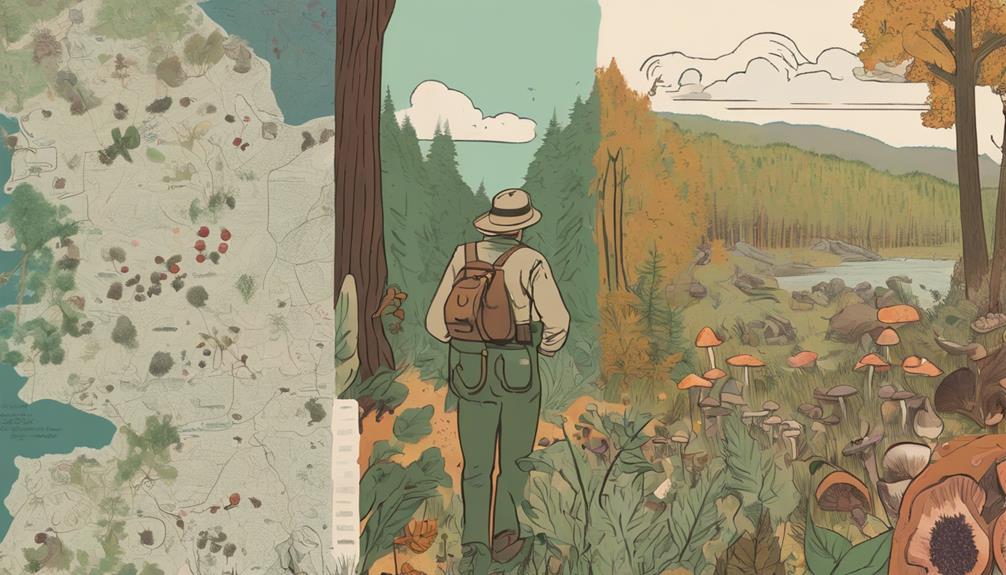
State parks implement specific harvest seasons to safeguard plant populations, ensuring that foragers like you can collect responsibly and sustainably. By understanding these harvest seasons, you can contribute to the conservation of state parks' natural resources.
Conservation efforts in state parks aim to maintain biodiversity and prevent over-harvesting, allowing for the long-term health of ecosystems and preserving future foraging opportunities.
When foraging in state parks, it's important to follow guidelines and regulations to preserve natural resources. You should familiarize yourself with the park's rules and restrictions on foraging, as they vary from park to park.
By doing so, you'll be supporting the conservation practices in state parks, which are necessary for maintaining the delicate balance of ecosystems. Remember, responsible foraging is key to ensuring the continued availability of wild edibles in state parks.
Foraging Ethics and Safety Guidelines
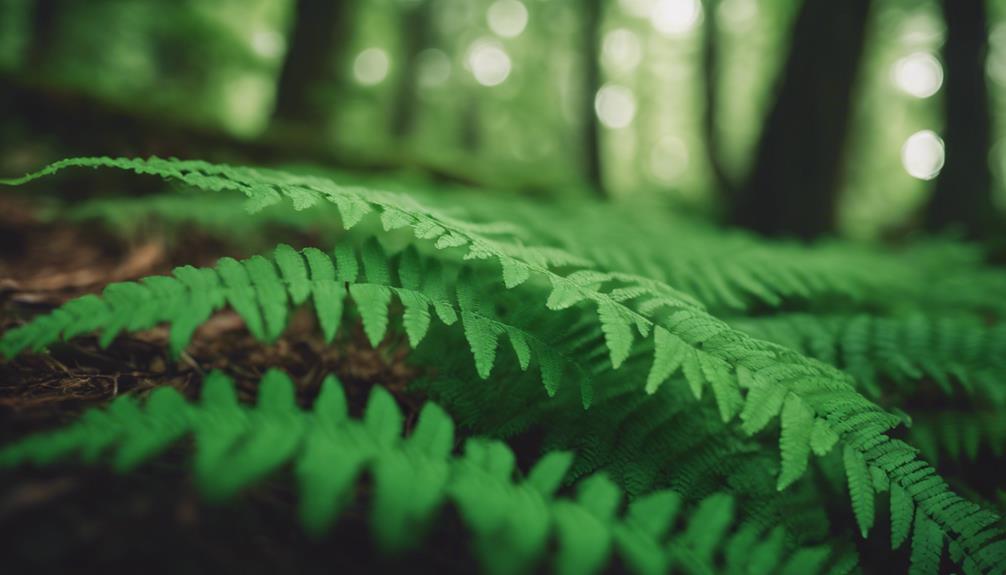
Responsible foraging in state parks demands adherence to a set of ethics and safety guidelines to guarantee a positive experience for both humans and the environment. By following these guidelines, you can confirm a safe and enjoyable foraging experience while preserving the natural environment.
To get started, remember these essential foraging ethics and safety guidelines:
- Respect park regulations: Always follow park rules and guidelines for ethical foraging practices to avoid fines or penalties.
- Preserve the environment: Leave no trace while foraging in state parks to maintain the natural environment and protect wildlife habitats.
- Prioritize safety: Stay safe by properly identifying plants, avoiding toxic lookalikes, and using tools safely to avoid accidents.
Plant Identification and Classification
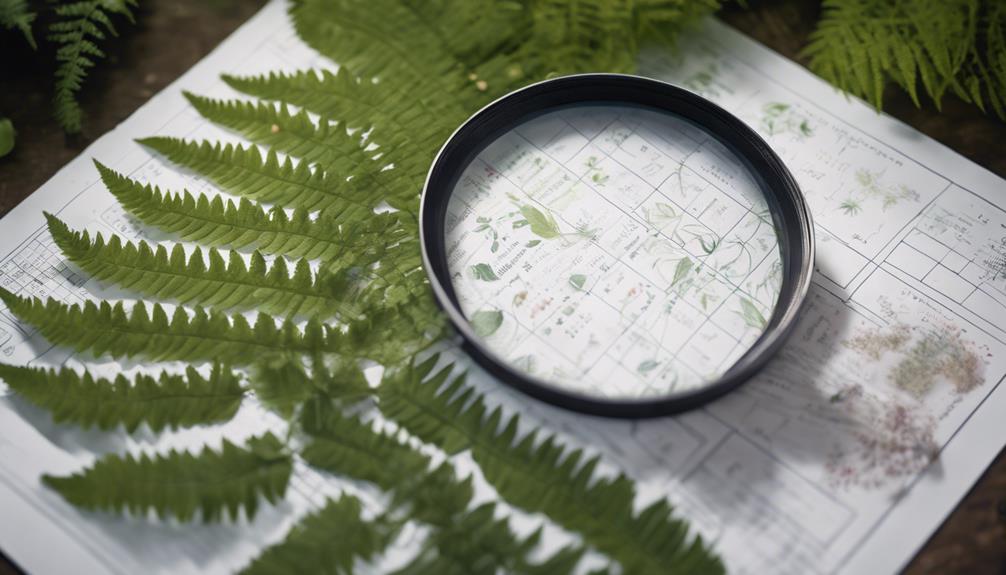
As you venture into the world of foraging in state parks, accurately identifying the plants you come across becomes an essential skill, and understanding plant classification is key to making that happen.
Plant identification involves learning to distinguish edible plants from toxic ones based on key characteristics, such as leaf shape, color, and arrangement. Understanding plant classification helps you identify species based on their scientific names, families, and characteristics.
For instance, knowing that a plant belongs to the carrot family (Apiaceae) can help you identify it as edible or toxic.
Foraging activities rely heavily on your ability to classify plants into groups like herbs, shrubs, trees, and vines, making it easier to organize and identify foraged species.
Knowledge of plant families also assists in grouping similar plants together for easier identification during foraging activities.
To aid in plant identification and classification, you can use field guides, apps, and resources that provide detailed descriptions and images of various plant species.
Frequently Asked Questions
Can You Forage in Local Parks?
You'll need to check with local park authorities or websites to see if foraging is allowed, as rules vary by location, and adhere to any posted signs or guidelines to promote sustainable foraging in local parks.
Can You Forage in MN State Parks?
You're wondering if you can forage in MN state parks – generally, the answer is no, unless you have a permit, but some parks allow limited personal use foraging, so it's best to check with park authorities for specific rules.
What States Is Foraging Legal In?
You'll find that foraging laws vary state by state, but some states like Texas and Arkansas allow it with restrictions, while others like California prohibit it; always check local regulations before you head out to forage.
Can You Forage in Michigan State Parks?
You'll be surprised to know that Michigan has over 100 state parks! Unfortunately, you can't forage in them, as it's generally prohibited to protect the ecosystem and wildlife, with specific rules varying by location.
Conclusion
As you stand in a state park, surrounded by nature's bounty, remember that foraging is a privilege, not a right.
The wild edibles you seek are nestled among protected ecosystems, private property boundaries, and conservation efforts.
By respecting these boundaries and adopting sustainable practices, you'll guarantee the land's integrity and your own safety.
Harvest wisely, and the forest will continue to flourish, its secrets waiting to be uncovered.
Foraging Guides
Do Foraging Wasps Sting? What You Need to Know!
Protect yourself from painful stings by understanding the motives behind foraging wasps' attacks and learning how to avoid their wrath.

When you're outdoors, you may encounter foraging wasps attracted to food smells or human odors. These wasps sting when they feel threatened or when protecting their nest. To minimize the risk of getting stung, wear light-colored clothing, avoid sudden movements, and stay calm. Foraging wasps sting to defend themselves, not to attack. Understanding wasp behavior and taking precautions can reduce the risk of stings. By being proactive, you can enjoy the outdoors while keeping stinging insects at bay. Now, discover more about wasp behavior, nest identification, and treatment options to stay safe this season.
Key Takeaways
- Foraging wasps sting when they feel threatened or are protecting their nest, and their primary goal is self-defense, not attack.
- Wearing white or pale colors can reduce the chances of being stung, as wasps are attracted to dark colors and human odors.
- Flapping or brushing off a foraging wasp can provoke it to sting, so it's essential to stay calm and move slowly.
- Foraging wasps can trigger allergic reactions, including anaphylaxis, and multiple stings can be dangerous, especially for those allergic to venom.
- Understanding wasp behavior and taking precautions can reduce the risk of stings, and being proactive can help minimize the dangers associated with their stings.
Understanding Wasp Behavior
When you're outdoors, understanding the behavior of foraging wasps can be your best defense against getting stung. Foraging wasps are attracted to food smells and human odors, making picnics and outdoor gatherings prime targets. Wearing white or pale colors can reduce the chances of being stung, as these colors are less likely to provoke an attack.
You should also be aware that flapping or brushing off a foraging wasp can provoke it to sting in self-defense. Remember, foraging wasps sting when they feel threatened or when protecting their nest. By understanding wasp behavior, you can take steps to avoid being stung.
Stay calm and move slowly if you encounter a foraging wasp, and avoid sudden movements that might provoke an attack. By being aware of your surroundings and taking simple precautions, you can minimize the risk of getting stung and enjoy the outdoors with confidence.
Why Foraging Wasps Sting
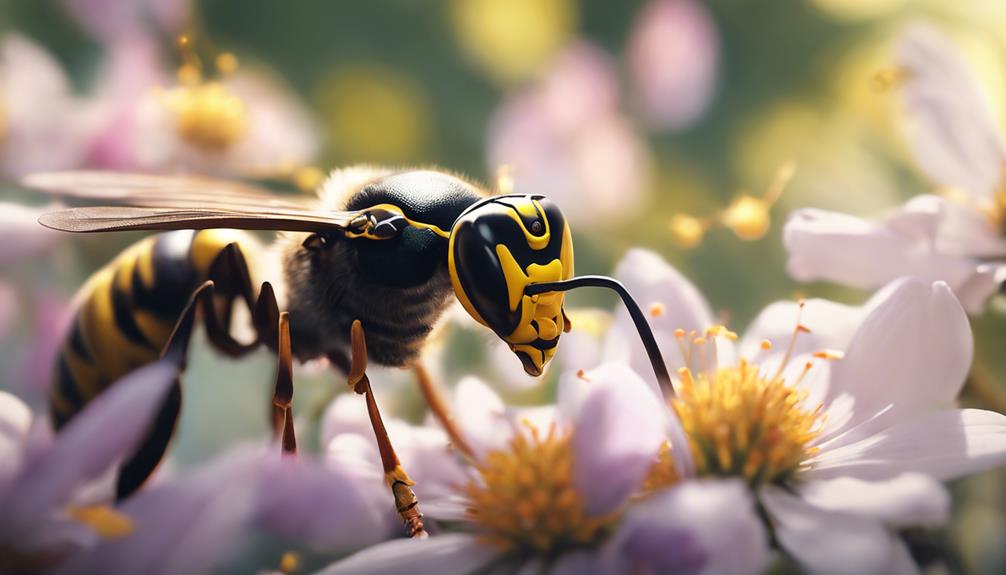
You're more likely to get stung by a foraging wasp if you unintentionally threaten its food source or nest, or if it mistakes you for a predator. When foraging for food, wasps can become aggressive if they feel threatened or provoked.
Their primary goal is self-defense and protection of their nest, and they'll sting if they perceive a threat. If you're near their food source, they might mistake you for a competitor and sting in defense.
It's essential to understand that foraging wasps sting to defend themselves, not to attack. They're generally not aggressive and will avoid encounters if possible. However, if they feel threatened, they won't hesitate to sting.
By being aware of their behavior and taking precautions, you can minimize the risk of stings. Avoid sudden movements, don't disturb their nests, and keep food and drinks covered to reduce the likelihood of encounters.
Wasp Sting Risks and Dangers
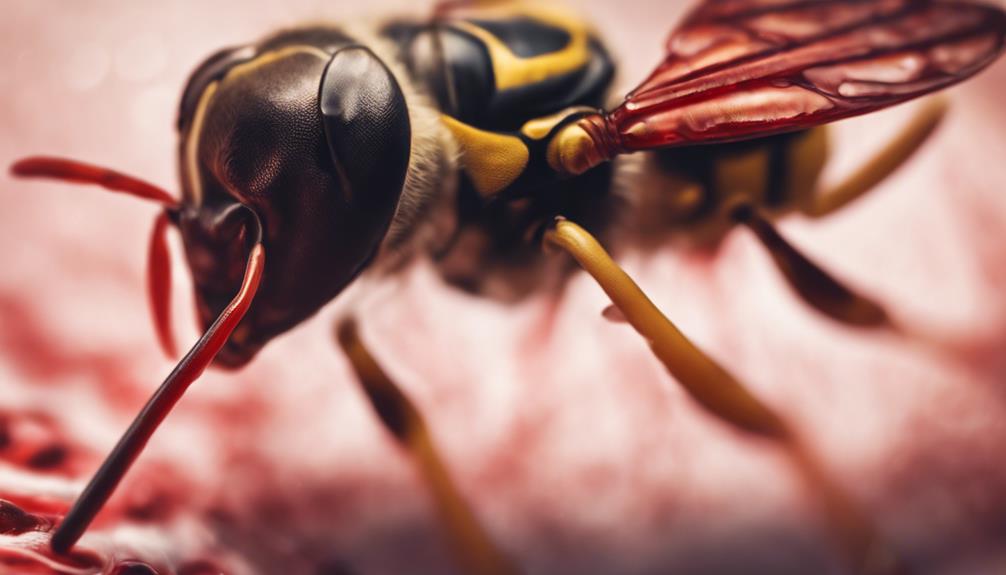
While understanding why foraging wasps sting is important, it's equally necessary to know the potential risks and dangers associated with their stings, which can cause more than just temporary pain and discomfort.
You should be aware that wasp stings can trigger allergic reactions, leading to severe consequences. In some cases, multiple wasp stings can cause anaphylaxis, a life-threatening condition that requires immediate medical attention.
Foraging wasps, in particular, are more aggressive when they feel threatened, and their stingers can inject venom, causing pain, redness, and swelling. If you're allergic to wasp venom, even a single sting can be dangerous.
It's crucial to take precautions when outdoors, especially in areas where wasps are known to nest. By understanding wasp behavior and taking necessary precautions, you can reduce the risk of being stung and minimize the dangers associated with wasp stings.
Preventing Wasp Encounters

By taking proactive steps to prevent unwanted encounters, you can greatly reduce the likelihood of crossing paths with foraging wasps.
One effective way to do this is by creating DIY wasp traps using water, beer, and sweet attractants like jam. Adding a splash of washing-up liquid guarantees trapped wasps drown, preventing further encounters. Placing multiple traps in areas where wasps frequent can markedly decrease their numbers.
When venturing near potential wasp habitats, avoid wearing dark colors, which can attract these insects. Before pruning trees or shrubs, take a moment to check for suspended nests, as disturbing them can provoke foraging wasps.
By taking these precautions, you can minimize the risk of unwanted encounters. By being proactive, you can enjoy the outdoors while keeping these stinging insects at bay.
Wasp Nest Identification Tips
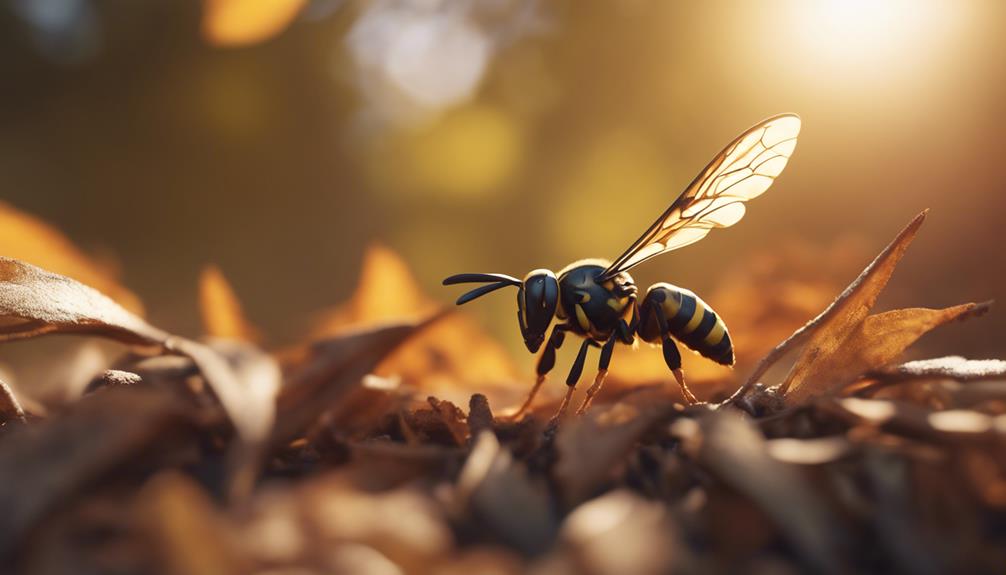
Identifying a wasp nest's location and type can be an important step in understanding the species you're dealing with and planning effective control strategies. When trying to identify a wasp nest, it's vital to approach with caution to avoid provoking defensive behavior from the wasps.
Here are some tips to help you identify a wasp nest:
- Look for paper-like material: Wasp nests are typically made of a paper-like material constructed by the wasps.
- Check the shape and size: Nests can vary in size and shape, with some being small and round while others are larger and more intricate.
- Determine the location: Paper wasps often build exposed umbrella-shaped nests, while yellowjackets prefer concealed underground nests.
- Observe from a safe distance: It's important to observe the nest from a safe distance to avoid disturbing the wasps and provoking an attack.
Avoiding Wasp Attractants
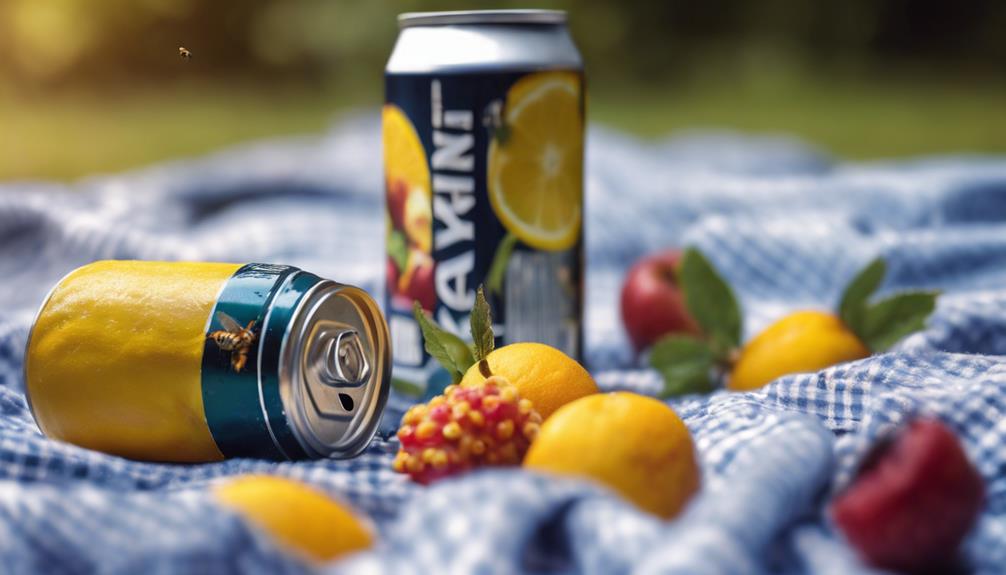
To minimize encounters with foraging wasps, you should take steps to avoid attracting them in the first place. One of the most effective ways to do this is to keep food and drinks covered.
When eating outdoors, be cautious not to leave any food remnants or spills behind, as these can quickly attract foraging wasps. It's also essential to avoid wearing sweet-smelling perfumes and lotions, as these can act as attractants.
When spending time outdoors, consider using insect repellent containing DEET to deter foraging wasps from approaching. Additionally, be mindful of your surroundings and avoid areas where food and drinks are being consumed.
If you're planning a picnic or BBQ, make sure to clean up promptly and dispose of trash properly. By taking these simple precautions, you can significantly reduce the likelihood of attracting foraging wasps and minimize the risk of an encounter gone wrong.
Safe Outdoor Practices

When you're outdoors, it's vital to take precautions to avoid attracting foraging wasps or provoking them into stinging.
You can start by wearing protective clothing, such as long-sleeved shirts and pants, to cover your skin. Additionally, it's important to avoid sudden movements, as these can be perceived as threats, leading to aggressive behavior from the wasps.
Wear Protective Clothing
When heading outdoors, it's crucial to wear long-sleeved clothing and closed-toe shoes to minimize exposed skin and reduce the risk of foraging wasp stings. Foraging wasps can sting if they feel threatened or provoked, so taking precautions is important. Wearing protective clothing is a simple yet effective way to safeguard yourself.
Here are some additional tips to keep in mind:
- Avoid loose clothing that may trap wasps or make it difficult to brush them away.
- Wear light-colored clothing, which is less attractive to foraging wasps than dark or bright colors.
- Keep your hair tied back to reduce the risk of wasps getting tangled in your hair.
- Don't wear sweet-smelling perfumes or lotions, which can attract foraging wasps.
Avoid Sudden Movements
You'll want to keep your movements slow and deliberate when outdoors, especially in areas where foraging wasps are present, since sudden movements can provoke them into stinging. When foraging wasps feel threatened or provoked, they can sting in self-defense. To prevent this, remaining calm and still if a wasp lands on you is crucial. Sudden movements, such as flapping or swatting at a foraging wasp, can trigger a defensive sting.
Here are some tips to help you avoid sudden movements and prevent stings:
| Action | Why It Helps | Tips |
|---|---|---|
| Move slowly | Avoids sudden movements | Walk calmly, avoid running or jumping |
| Remain calm | Reduces stress and panic | Take deep breaths, stay relaxed |
| Wear light-colored clothing | Less attractive to wasps | Avoid dark or bright colors |
| Be aware of surroundings | Helps you avoid wasps | Watch for wasps, stay alert |
Wasp Sting Treatment Options
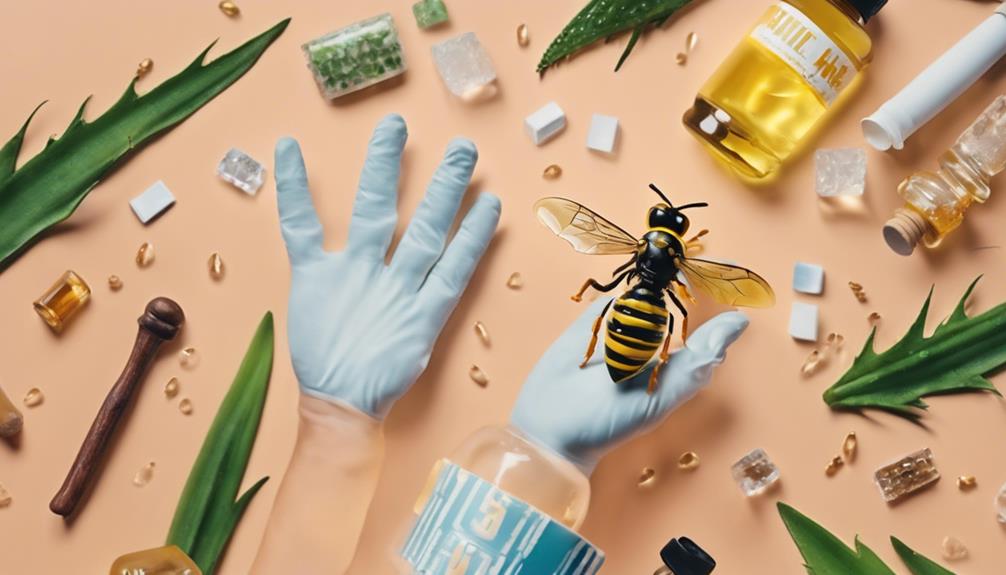
If you've been stung by a foraging wasp, your first step should be to wash the affected area with soap and water to prevent infection. This simple act can make a big difference in reducing the risk of infection.
To further alleviate the discomfort, consider the following treatment options:
- Remove the stinger: Gently scrape out the stinger with a credit card or your fingernail to reduce venom injection.
- Apply a cold pack: Elevate the affected area and apply a cold pack to reduce swelling and pain.
- Take medications: Over-the-counter antihistamines and acetaminophen can help with itching and discomfort.
- Seek medical attention: If you experience difficulty breathing, chest tightness, or other severe symptoms, seek immediate medical attention.
Controlling Wasp Populations
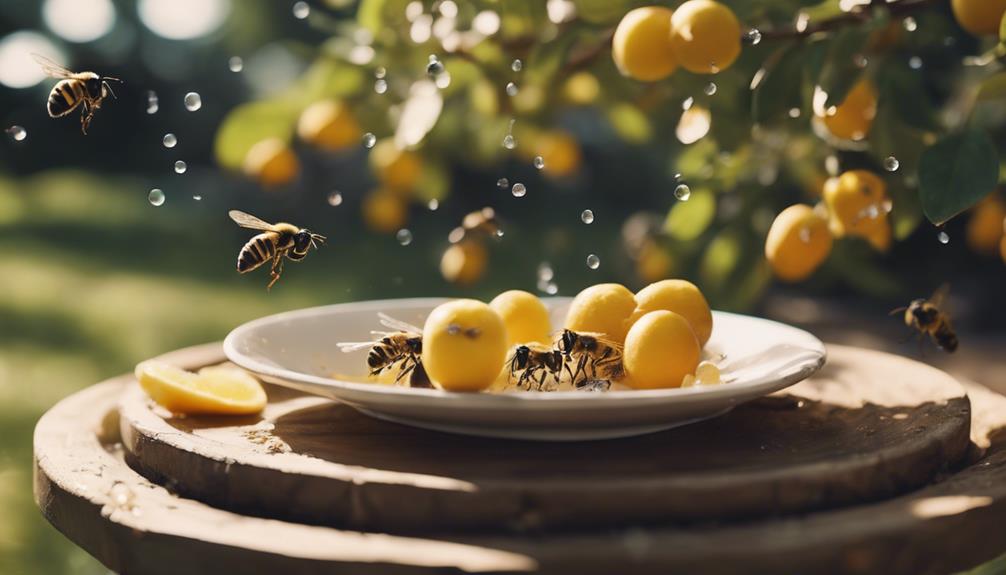
In order to prevent foraging wasps from taking over your outdoor space, controlling their populations through a combination of preventative measures and targeted elimination strategies is essential.
Start by securing food sources, such as trash cans and pet food, to prevent foraging wasps from being attracted to your property. You can also set up traps baited with rotting fish and soapy water to catch foraging wasps and reduce their numbers.
For smaller nests, remove them early to prevent further population growth and potential stings. However, for larger nests, it's best to spray them at night with insecticides to effectively control and eliminate established wasp colonies.
Remember to wear protective gear and consider seeking professional help for above-ground nests to ensure safe and efficient population control.
Minimizing Wasp Threats
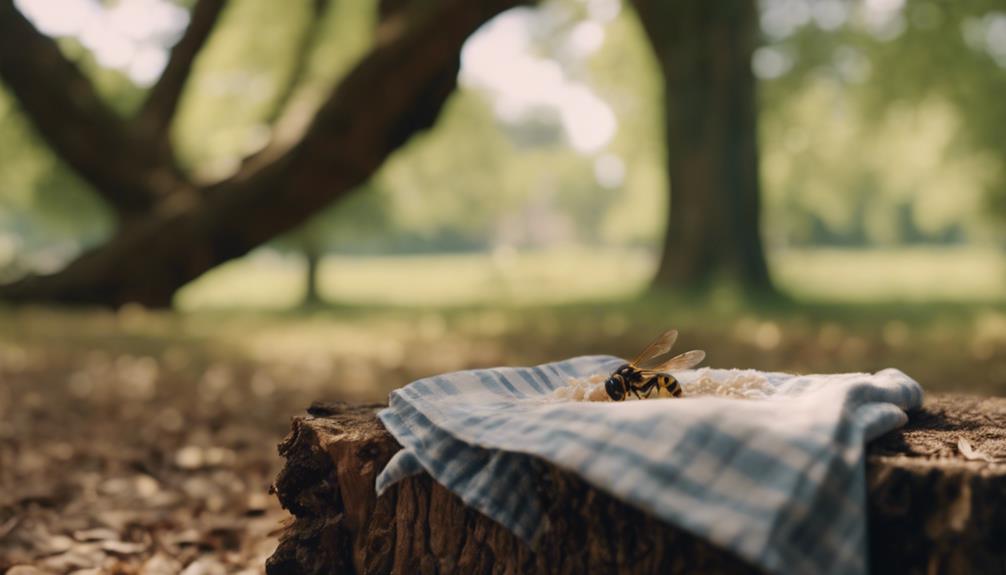
By taking proactive steps, you can minimize the threat of foraging wasps and reduce the risk of painful stings. When it comes to avoiding encounters with these stinging insects, being prepared is key.
Here are some essential tips to keep in mind:
- Avoid attracting foraging wasps: Refrain from wearing sweet scents or perfume, as these can attract wasps. Opt for light-colored clothing instead of dark or bright colors, which can provoke stinging.
- Use DIY wasp traps: Create your own wasp trap using sweet attractants to capture and remove foraging wasps from your surroundings.
- Stay calm if approached: If a foraging wasp lands on you, remain still and calm. Avoid sudden movements, as this can provoke stinging.
- Be cautious in wasp-prone areas: When entering areas where foraging wasps are present, exercise caution to prevent unpleasant encounters.
Frequently Asked Questions
Do Foraging Wasps Sting?
You're wondering if foraging wasps sting, and the answer is, they usually don't, unless you threaten or provoke them while they're focused on gathering food for their colony.
Do You Need to Do Anything for a Wasp Sting?
When you're stung, you'll want to remove the stinger quickly, apply a cold compress, and take over-the-counter pain relievers to alleviate symptoms; if you experience severe reactions, seek medical attention right away.
Can a Wasp Sting You Without You Knowing?
You're wandering through a sunny meadow, oblivious to the sneaky wasp that's just slipped in a stealthy sting, leaving you none the wiser – that is, until the delayed reaction kicks in, leaving you wondering what hit you.
Will a Wasp Sting You if It Lands on You?
If a wasp lands on you, it won't necessarily sting; it's likely foraging for food. You won't get stung unless you provoke it, so remain calm, still, and gently brush it off if needed, and you'll minimize the risk of getting stung.
Conclusion
As you venture outdoors, remember that foraging wasps are just doing their job, but that doesn't mean you have to become their next target. By understanding their behavior, taking preventive measures, and knowing how to treat stings, you can minimize the threat of these buzzing insects.
So, stay informed, stay vigilant, and don't let wasps ruin your outdoor fun – after all, knowledge is the best defense against these unwanted visitors.
Foraging Guides
Do Forage Soybeans Produce Pods? Learn the Facts!
Curious about forage soybeans and pod production? Discover the surprising answer and its implications for deer nutrition and food plot management.
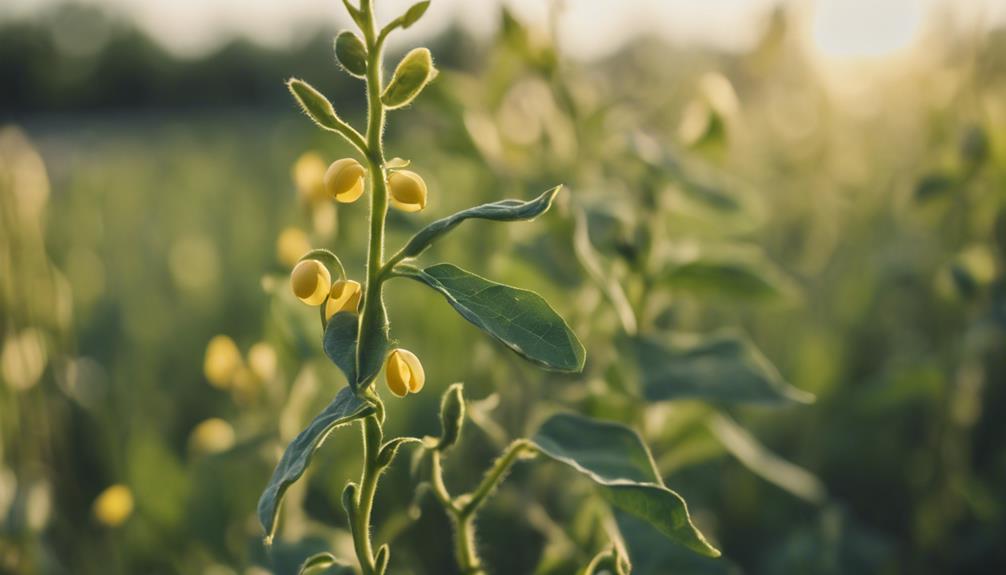
You're curious about forage soybeans and pod production. The answer is yes, forage soybeans like Eagle Forage Soybeans are bred to prioritize pod production, yielding large, nutritious pods that attract and nourish deer. These pods are high in protein and calories, making them an ideal food source for deer. Continued flowering in September guarantees a sustained food supply, reducing browse pressure on other crops. To learn more about the benefits of forage soybeans for deer and how to maximize pod yield and quality, explore the world of forage soybean production and discover how to create a thriving food plot.
Key Takeaways
- Forage soybeans, like Eagles, produce high-quality pods that attract deer and provide a valuable food source.
- These pods are rich in essential nutrients, offering a sustainable food supply with continued flowering.
- Forage soybeans prioritize pod production, outperforming traditional ag beans in deer-heavy areas.
- The larger pod size of forage soybeans benefits deer health and activity, making them a top choice for hunting plots.
- Proper planting and management strategies can significantly boost pod yield and quality in forage soybeans.
Understanding Forage Soybean Production
When you plant forage soybeans, you're not only providing a valuable food source for deer, but also setting the stage for a successful harvest. These soybeans are known for their exceptional pod production, which is a major draw for deer. The high-calorie and protein content in the pods is what makes them so attractive to these animals. In fact, the exceptional deer activity in soybean plots can be attributed to the nutritional value of the pods.
Forage soybeans like Eagles are a popular choice for food plots, especially in deer-heavy areas. This is because they outperform agricultural beans in these regions.
By planting forage soybeans, you're not only providing a food source for deer but also reducing browse pressure on other crops. This promotes a sustainable food source and helps maintain a healthy ecosystem.
Pod Formation and Development

You'll find that the formation and development of pods on forage soybeans like Eagles is a critical process that directly impacts the availability of food for deer.
As these pods grow, they become a valuable source of nutrition for deer, and their size is significant. Forage soybeans like Eagles impress with high pod production, guaranteeing a sustained food supply.
Continued flowering in September ensures that deer have a steady supply of food throughout the season. The result is a deer attraction like no other, with high pod yields and nutritional content that benefits deer health and activity.
By understanding how these pods form and develop, you'll appreciate the value of forage soybeans in your food plots.
With their exceptional pod production, forage soybeans outperform ag beans in areas with heavy deer pressure, making them a top choice for food plots.
Nutritional Value of Soybean Pods
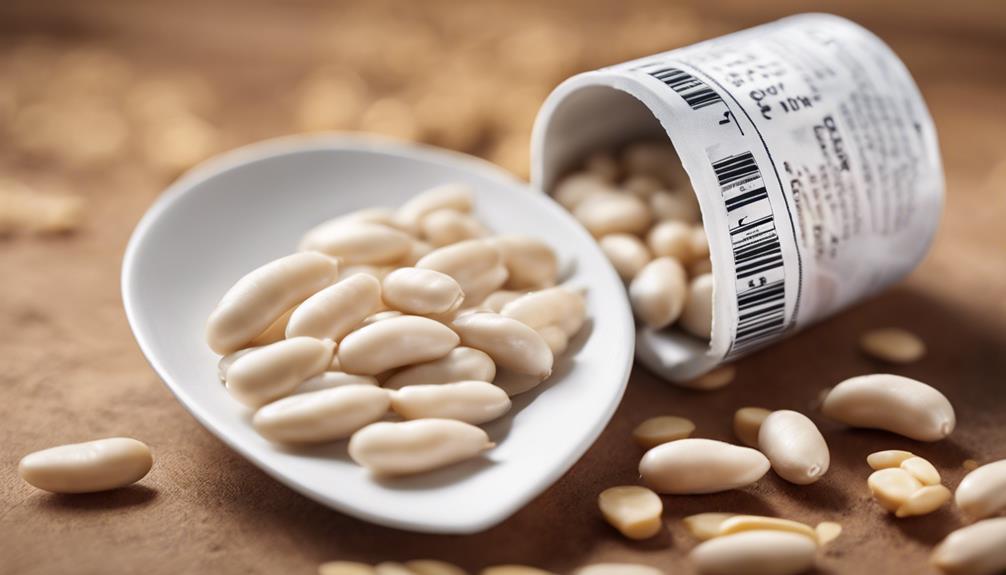
Rich in protein and essential nutrients, soybean pods provide a highly nutritious food source that supports the health and well-being of deer, making them an attractive and valuable component of your food plots.
As you consider incorporating forage soybeans into your wildlife management strategy, it's essential to understand the nutritional value of these pods.
Here are some key benefits of soybean pods:
- High in protein, making them an ideal food source for deer
- Rich in essential nutrients, supporting overall health and well-being
- Provides a sustainable food source, with continued flowering in September ensuring a steady supply of pods
- Offers a balance of pod yield and deer nutrition benefits, making them a popular choice for food plots
- Supports exceptional deer attraction, leading to increased deer activity in these areas
Attracting Wildlife With Soybeans
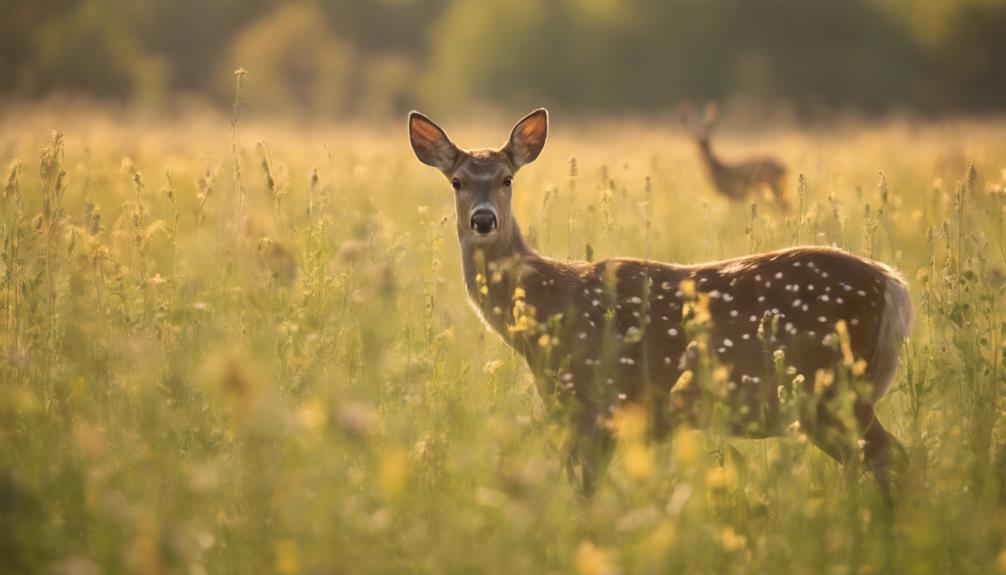
As you consider using forage soybeans to attract wildlife, you're likely wondering how they can benefit your land and the animals that inhabit it.
You'll be pleased to know that forage soybeans like Eagles offer a trifecta of benefits, providing a nutritious food source, attracting deer and other wildlife, and creating a thriving habitat.
Let's explore how forage soybeans can be a valuable addition to your wildlife management strategy.
Food Plot Benefits
How do forage soybeans become a magnet for deer, and what makes them an attractive addition to your food plot? The answer lies in their exceptional pod production, which provides a consistent and abundant food source for wildlife.
Here are just a few benefits of incorporating forage soybeans into your food plot:
- High pod yields attract deer and keep them coming back for more
- Large pods continue to develop into September, providing sustained nutrition for deer
- Soybean plots with high pod production see exceptional deer activity, making them a popular choice for food plots
- Forage soybeans offer a balance of high-calorie and protein content, making them a valuable food source for deer
- By planting forage soybeans, you can reduce browse pressure on other crops, ensuring a sustainable food supply for deer
Attracting Deer Habitat
By incorporating forage soybeans into your food plot, you're not only providing a valuable food source but also creating an attractive habitat that draws deer in and keeps them coming back.
The exceptional deer attraction of forage soybeans is evident in their high pod production, with varieties like Eagles impressing with their abundant pods. The large pod size and continued flowering in September make soybean plots exceptionally attractive to deer, which is reflected in the high deer activity observed in these areas.
As a preferred food source, forage soybeans outperform agricultural beans in deer-heavy areas, enhancing wildlife habitat. By choosing forage soybeans like Eagles, you're creating a habitat that deer will love, with high-calorie and protein content that meets their nutritional needs.
Wildlife Nutrition Source
Forage soybeans like Eagle provide a power-packed nutrition source for wildlife, offering high-calorie and protein-rich pods that drive deer activity and attract them to your plot. As you consider planting forage soybeans, you'll want to know that these pods are a key attraction for deer, with high deer activity observed in soybean plots due to the appealing pod production.
Here are some benefits of using forage soybeans as a wildlife nutrition source:
- High-calorie and protein-rich pods attract deer and drive activity
- Pods are produced in abundance, providing a sustainable food source for wildlife
- Continued flowering in September means sustained nutrition for wildlife throughout the season
Comparing Forage to Traditional Soybeans
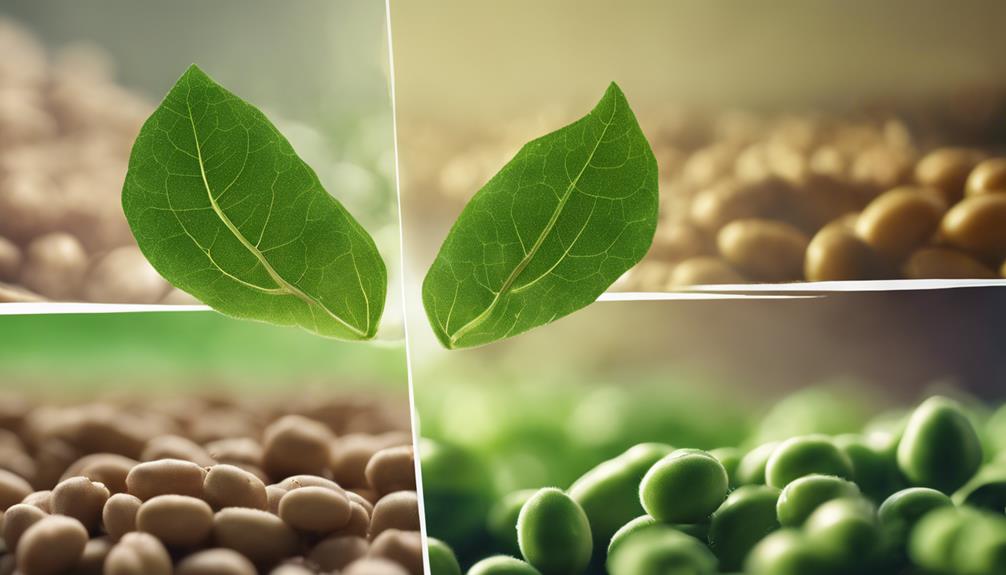
As you explore the differences between forage and traditional soybeans, you'll notice that their growth habits and seed sizes differ greatly.
For instance, forage soybeans are bred for their pod production, whereas traditional soybeans focus on grain yield.
Now, let's examine the key points that set these two types of soybeans apart, including their distinct growth habits, varying seed sizes, and differing yield expectations.
Growth Habits Differ
You'll notice distinct differences in growth habits between forage soybeans and traditional soybeans, particularly when it comes to their reproductive strategies.
While traditional soybeans focus on producing seeds, forage soybeans prioritize pod production to attract deer. This difference in reproductive strategy affects how they grow and develop.
Here are some key differences in growth habits:
- Reproductive strategy: Forage soybeans focus on pod production, while traditional soybeans focus on seed production.
- Flowering period: Forage soybeans continue flowering into September, providing a sustained food source for deer.
- Pod yield: Forage soybeans produce high pod yields, benefiting deer attraction and providing a high-calorie, high-protein food source.
- Growth performance: Forage soybeans like Eagle Forage Soybeans outperform traditional ag beans in deer-heavy areas due to their pod production and deer nutrition benefits.
- Deer attraction: Forage soybeans' high pod production and nutritional benefits make them a top choice for deer attraction in hunting plots.
These differences in growth habits are essential to understanding how forage soybeans can benefit your hunting plot.
Seed Size Matters
When it comes to pod production, the size difference between forage and traditional soybeans is a key factor in attracting and nourishing deer. You'll notice that forage soybeans like Eagles produce pods that are larger in size and quantity, making them highly attractive to deer.
In contrast, traditional soybeans have smaller pods and are primarily grown for harvesting the beans. The larger pod size of forage soybeans provides additional forage and nutrition for deer, enhancing their overall health and activity in soybean plots.
As you consider planting forage soybeans, remember that they prioritize pod production for wildlife, unlike traditional soybeans. This focus on pod production means forage soybeans will continue to flower in September, producing more pods and extending the availability of food for deer throughout the hunting season.
Yield Expectations
Forage soybeans, like Eagle Forage Soybeans, greatly surpass traditional soybeans when it comes to pod yield, offering a more abundant food source for deer. You'll be impressed by the significant difference in yield, making forage soybeans an attractive option for deer managers and enthusiasts.
Here are some key benefits of forage soybeans:
- Higher pod yield compared to traditional soybeans, providing a sustainable food source for deer
- Larger pod size, ensuring a more abundant food source
- Continued flowering into September, extending the food source for deer
- Outperform traditional ag beans in pod yield, especially in deer-heavy areas
- Offer a balance of high-calorie and protein content, making them a valuable food source for deer
Maximizing Pod Yield and Quality
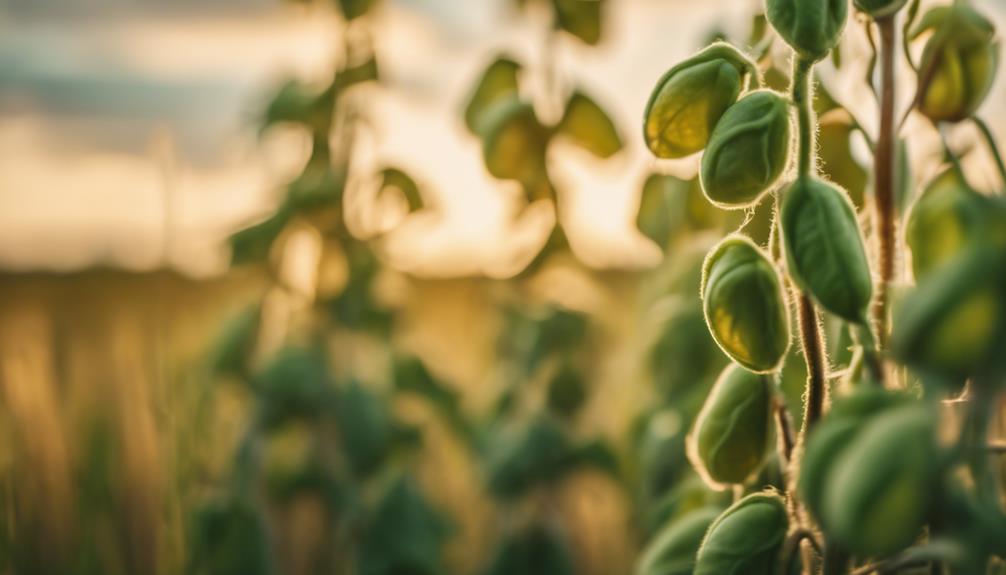
By selecting the right variety, like Eagles, and implementing ideal planting and management strategies, you can greatly enhance pod production and quality in your forage soybean plots.
To maximize yield and quality, it's vital to provide ideal growing conditions for your forage soybeans. This includes choosing a well-drained soil with a pH between 6.0 and 7.0 and ensuring adequate moisture and sunlight.
Planting at the right time, typically in late spring or early summer, also plays an important role in promoting healthy growth and pod production.
Moreover, incorporating proper fertilization and pest management techniques can significantly boost pod yield and quality.
By following these guidelines, you can expect impressive pod production, similar to Eagles, which boasts high-calorie and protein-rich pods that are highly attractive to deer.
With the right approach, you can create a thriving forage soybean plot that meets the nutritional needs of deer and supports their overall health and well-being.
Frequently Asked Questions
Do Forage Soybeans Produce Pods?
You're wondering if forage soybeans produce pods, and the answer is a resounding yes! In fact, forage soybeans like Eagle beans are known for their impressive pod production, providing a valuable food source for deer and other wildlife.
What Is the Difference Between Forage Soybean and Regular Soybean?
You're wondering what sets forage soybeans apart from regular ones. The key difference is that forage soybeans prioritize pod production for wildlife, unlike regular soybeans, which focus on seed production for human consumption.
Do Soybean Flowers Turn Into Pods?
"As you wander through the soybean field, wondering if flowers turn into pods, remember that magic happens after pollination, and yes, you'll find those tiny flowers transforming into pods, bearing seeds for harvest."
Do Soybeans Come in Pods?
You're wondering if soybeans come in pods? Yes, they do! Soybeans grow in pods, typically containing 2-4 beans each, with varying sizes depending on the soybean variety.
Conclusion
You've learned the facts about forage soybeans, and it's clear: these incredible legumes can do it all!
From producing nutritious pods to attracting wildlife, forage soybeans are a game-changer for farmers and outdoor enthusiasts alike.
With the right strategies, you can maximize pod yield and quality, accessing a treasure trove of benefits.
So, don't settle for mediocre crops – harness the power of forage soybeans and watch your fields thrive like a million bucks!
Foraging Guides
Do Forage and Orange Rhyme? Find Out the Linguistic Truth!
Tune in to uncover the surprising truth behind the seemingly perfect rhyme between forage and orange.
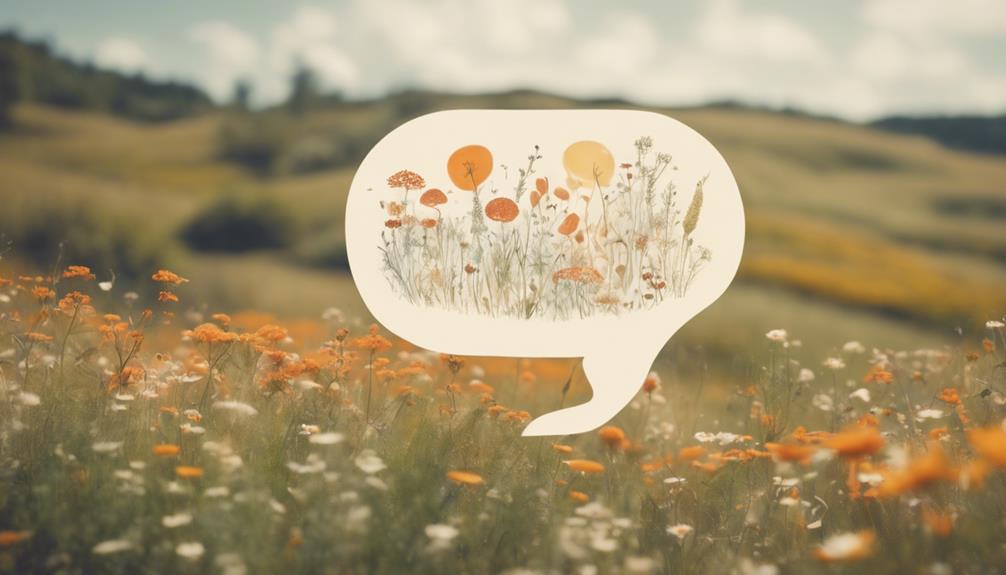
When you examine the words "forage" and "orange," you might think they rhyme due to their similar ending sounds. But, do they really? The answer lies in their phonetic differences. "Orange" has a unique vowel sound, making it challenging to find perfect rhymes. "Forage" is a creative but imperfect match. While they share a similar sound, their vowel sounds and stress patterns differ. You might think they rhyme, but linguistically, they don't quite fit. Want to understand the nuances of rhyming and how language influences our perception of it? There's more to explore on this complex topic.
Key Takeaways
- The unique vowel sound in 'orange' makes it challenging to find perfect rhymes, and 'forage' is an imperfect but creative match.
- Phonetic transcription reveals that 'orange' and 'forage' have distinct vowel sounds, disqualifying them as a perfect rhyming pair.
- Linguistic factors like phonetic similarities, stress patterns, and syllable structures affect rhyme perception, and 'orange' and 'forage' differ in these aspects.
- Individual differences in interpretation, accent, and cultural background influence what sounds like a perfect rhyme, making rhyming perception subjective.
- Despite Eminem's creative rhyming with 'orange', linguistically, 'forage' and 'orange' do not perfectly rhyme due to their distinct phonetic features.
Rhyme Perception and Variability
When you consider the rhyme between forage and orange, you quickly realize that individual differences in interpretation and accent can greatly influence your perception of whether these words actually rhyme.
This highlights the intricate nature of rhyme perception, which can vary significantly from person to person. Factors like phonetic similarity and stress placement play a substantial role in shaping our judgments about word rhymes.
As a result, linguistic studies have revealed differing opinions on whether words like forage and orange truly rhyme. Pronunciation variations, in particular, can profoundly impact the perceived rhyme between these words.
For instance, some people may pronounce 'orange' with a stronger emphasis on the second syllable, making it sound more like 'forage.' Others may pronounce it with a shorter 'o' sound, making it sound less like a rhyme. These variations can lead to conflicting opinions on whether these words share a true rhyme.
Understanding these nuances is essential in grasping the intricacies of linguistic analysis and the complexities of word rhymes.
The Sound of Orange in Context

When exploring the unique vowel sound of 'orange' in context, you'll find that its ending sound defies easy rhymes, making 'forage' a creative, yet imperfect, match.
When it comes to rhyming with orange, you'll discover that it's a challenging task due to its distinct vowel sound.
Here are some key points to keep in mind when attempting to rhyme with orange:
- The word 'orange' has a unique vowel sound, making it difficult to find perfect rhymes.
- 'Forage' is often used as a rhyme, but it's not a perfect match due to differences in ending sounds.
- Creative techniques like slant rhyme can be used to rhyme 'orange' with words like 'forage' in poetic contexts.
- Eminem's lyrics showcase the flexibility of language in rhyming, even with challenging words like 'orange'.
- The phonotactic constraints of English limit rhyming options for words like 'orange' and 'forage'.
Keep in mind that while 'orange' and 'forage' don't perfectly rhyme, they can still be used together in creative ways. By understanding the unique sound of 'orange', you'll be better equipped to explore the possibilities of rhyming with this challenging word.
Phonetics and Phonetic Transcription
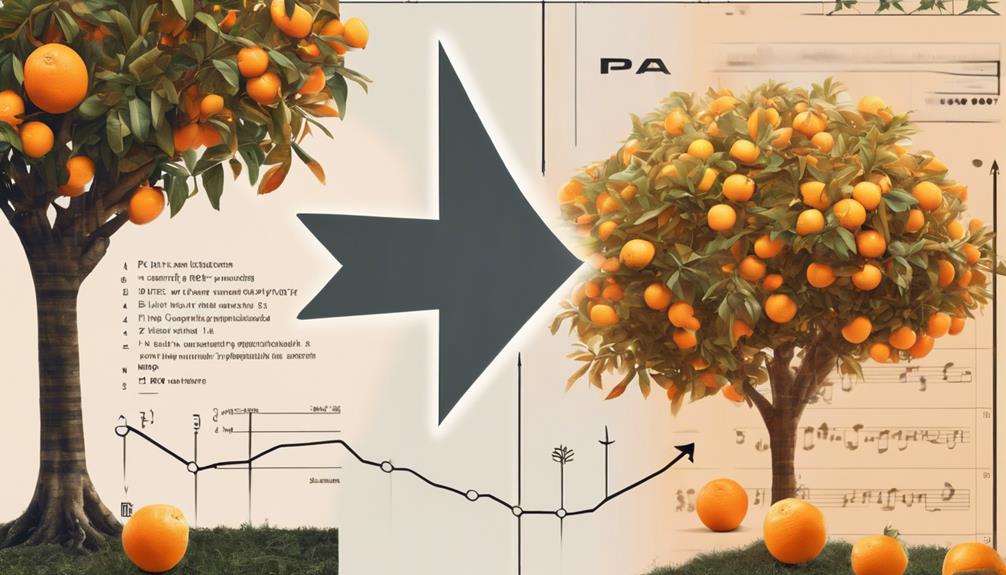
As you explore the world of phonetics and phonetic transcription, you'll learn how to represent sounds using special symbols.
These symbols, called phoneme symbols, help you break down words into their individual sounds, like the 'f' and 'or' sounds in 'forage' and 'orange'.
Sound Representation
You start to represent speech sounds in a standardized way by using phonetic transcription, which assigns unique symbols to each sound. This is important for understanding the sounds of words like 'orange' and 'forage'.
When analyzing the rhyming potential of these words, it's necessary to break down their individual sounds.
Here are some key aspects of sound representation:
- Phonetic transcription uses symbols to represent speech sounds in a standardized way.
- Each symbol corresponds to a specific sound or combination of sounds.
- The transcription of a word shows the individual sounds that make up the word.
- By comparing the transcriptions of two words, you can determine their rhyming potential.
- Accurate sound representation is crucial for understanding the phonetic details of words like 'orange' and 'forage'.
Phoneme Symbols Used
You'll use phoneme symbols to break down the individual sounds in words like 'orange' and 'forage', allowing you to analyze their rhyming potential at the phonetic level.
These symbols are essential in phonetics, as they represent individual sounds in language.
When you transcribe spoken language into written form, you'll use phoneme symbols to capture the precise sounds of words.
For instance, symbols like /t/, /p/, and /s/ represent specific speech sounds in phonetics.
By using phoneme symbols, you can identify the distinct sounds within words, which is important for analyzing their rhyming potential.
Understanding phoneme symbols is crucial for studying the phonetics of a language, as it enables you to dissect words into their individual sounds.
This knowledge will help you determine whether 'orange' and 'forage' truly rhyme or not.
As you explore further into phonetics, you'll rely on phoneme symbols to uncover the intricacies of language.
Transcription Conventions
To accurately capture the sounds of spoken language, phonetic transcription relies on a standardized set of symbols from the International Phonetic Alphabet (IPA), assigning a unique symbol to each distinct speech sound. This allows you to precisely represent the sounds of speech, making it a crucial tool for linguists and language learners.
When working with phonetic transcription, you'll encounter various conventions that help you accurately document and study the pronunciation of words. Here are some key aspects to keep in mind:
- Symbols and Diacritics: IPA symbols and diacritics are used to represent speech sounds, including vowels, consonants, and tone markers.
- Transcription Types: There are two main types of phonetic transcription: broad and narrow. Broad transcription focuses on phonemes, while narrow transcription captures more detailed phonetic features.
- Word and Sentence Transcription: Phonetic transcription can be applied to individual words or entire sentences, helping you analyze the phonetic aspects of language.
- Phonetic Environment: The surrounding sounds and context can affect the pronunciation of a word, and phonetic transcription takes this into account.
- Language-Specific Conventions: Transcription conventions may vary depending on the language being studied, so understanding the specific conventions used for your language of interest is crucial.
Historical Development of Rhyming Words

The intricate evolution of rhyming words in the English language unfolds as a fascinating narrative, where linguistic innovations and poetic experiments have continuously reshaped the art of rhyming over time. You might be surprised to learn that words like "forage" and "orange" share a special connection.
| Rhyming Words | Shared Features |
|---|---|
| forage, orange | same ending sound |
| forage, orange | same stressed syllable pattern |
| orange, forage | phonetic similarity |
| forage, orange | enhanced rhyme compatibility |
| orange, forage | creative possibilities in English rhyme schemes |
As you explore the historical development of rhyming words, you'll discover how poets and linguists have pushed the boundaries of language. The connection between "forage" and "orange" is just one example of the versatility of English pronunciation and poetic expression. By examining the evolution of rhyming words, you'll gain a deeper understanding of the linguistic innovations that have shaped the art of rhyming over time.
Orange and Forage: A Critical Analysis
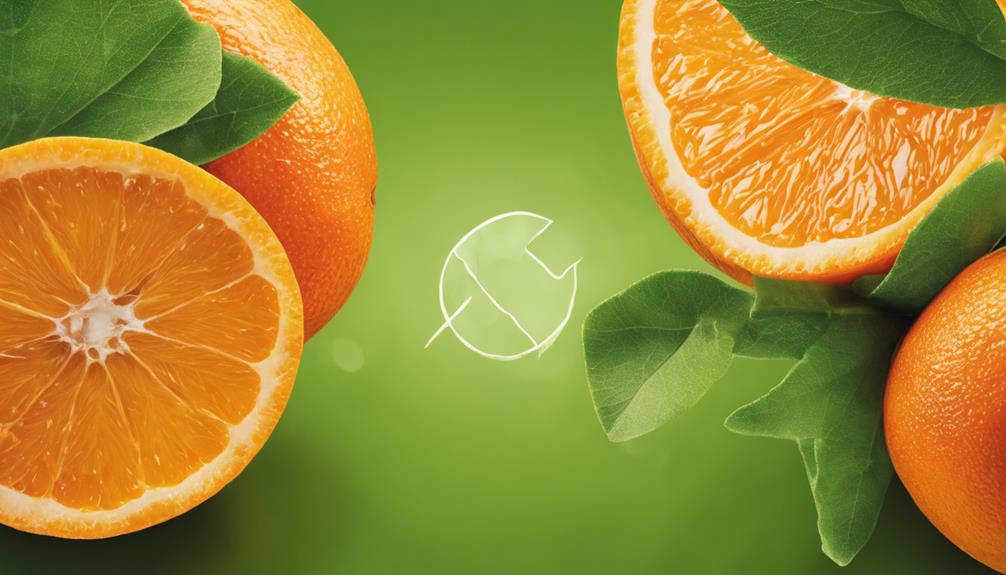
Delving into the phonetic nuances of 'orange' and 'forage', it becomes clear that these words defy perfect rhyming due to their distinct vowel sounds. As you explore the linguistic landscape, you'll find that these English words don't quite fit the bill as a rhyming pair.
Here are some key points to explore:
- The vowel sounds in 'orange' and 'forage' are distinct, making perfect rhyming impossible.
- The pronunciation of 'orange' and 'forage' isn't similar enough to qualify as a rhyming pair.
- Despite similarities in spelling, the phonetic differences between 'orange' and 'forage' are too great to overcome.
- The linguistic analysis reveals that 'orange' and 'forage' don't meet the criteria for rhyming.
- The truth is that 'orange' and 'forage' don't form a rhyming pair in English, despite their similarities.
Linguistic Factors Affecting Rhyme Perception

When you examine the intricacies of rhyme perception, you'll discover that linguistic factors like phonetic similarities, stress patterns, and syllable structures play a significant role in determining whether words like 'forage' and 'orange' truly rhyme. These factors can either strengthen or weaken the connection between words, making them more or less likely to rhyme in your mind.
| Linguistic Factor | Description | Impact on Rhyme |
|---|---|---|
| Phonetic Similarities | Similar sounds at the end of words | Increases rhyme likelihood |
| Stress Patterns | Emphasis on specific syllables | Affects word pairing in rhyming contexts |
| Syllable Structures | Number and arrangement of syllables | Influences word-to-rhyme compatibility |
The Subjectivity of Rhyming in Language

As you explore the complexities of rhyming, you'll notice that your perception of sound plays a significant role in determining what rhymes and what doesn't.
Additionally, your linguistic and cultural background can also influence your judgment, introducing a level of subjectivity to the process.
Now, let's examine how these factors intersect and impact our understanding of rhyming in language.
Perception of Sound
Your linguistic background plays a significant role in determining what sounds like a perfect rhyme to you. The way you perceive rhyming words is influenced by your regional accent, dialect, and personal experiences. This means that what sounds like a perfect rhyme to you mightn't be the same for someone else.
When it comes to rhyming, it's all about the similarity of sounds at the end of words. However, this can vary depending on the context and the individual. For instance:
- Regional accents can affect how we pronounce words, which in turn affects our perception of rhymes.
- Dialects can also influence our understanding of what constitutes a rhyme.
- Personal experiences and exposure to different languages can shape our perception of rhyming words.
- Cultural background can influence our perception of rhymes, especially in multilingual societies.
- Idiomatic expressions and colloquialisms can also impact our understanding of rhyming words.
As you can see, the perception of rhyming is complex and influenced by many factors. This is why debates arise over whether words like 'forage' and 'orange' rhyme. Ultimately, the perception of rhyme is subjective and can vary greatly from person to person.
Linguistic Cultural Bias
In your linguistic and cultural landscape, the notion of rhyming is filtered through a complex web of biases and influences that shape your perception of what sounds alike. You may think that rhyming is an objective concept, but it's not.
Rhyming perception can be influenced by cultural biases and regional dialects. Individual interpretations of rhyme can vary based on linguistic backgrounds. The subjectivity of rhyming in language leads to diverse opinions on word pairs like 'forage' and 'orange.'
Cultural Factor:
- Regional Dialects: Influences what sounds alike
- Cultural Background: Shapes individual interpretations
- Personal Experiences: Affects exposure to speech patterns
- Linguistic History: Impacts perception of rhyming relationships
- Social Environment: Influences evaluation of word pairs
Your personal experiences, cultural background, and social environment all play a role in how you perceive and evaluate rhyming relationships in language. This subjectivity leads to differing opinions on what constitutes a rhyme.
Frequently Asked Questions
Is It True That No Word in the Dictionary Rhymes With Orange?
You're wondering if it's true that no word in the dictionary rhymes with orange. Well, technically, yes, there's no perfect rhyme for orange, but you'll find approximate rhymes like forage and door hinge, and even Eminem's creative workarounds.
Is Rhyming a Linguistic Feature?
You're wondering if rhyming is a linguistic feature, and the answer is yes! Rhyming is a fundamental aspect of language, involving phonetic patterns and sound similarities, which helps analyze language structure and creativity in poetry, literature, and language development.
What Rhymes With Orange in Another Language?
You're curious about what rhymes with orange in another language. Surprisingly, in Welsh, 'oren' rhymes with 'Blorenge', a mountain, while French and Spanish offer unique rhyming possibilities for orange-like words, showcasing linguistic creativity.
Why Can't You Rhyme With Orange?
You stumble upon the puzzle of orange's rhyming limitations, and it's like trying to find the Holy Grail – the phonotactic rules and unique vowel sound make it a linguistic unicorn, defying perfect rhymes, leaving you to get creative like Eminem.
Conclusion
As you explore the world of words, you'll find that forage and orange don't quite fit the rhyming bill.
Historical hijinks, phonetic fluctuations, and linguistic loopholes all contribute to this mismatch.
While our brains may beg to differ, the facts are clear: these two words refuse to rhyme.
So, the next time you're tempted to tout this twosome as a perfect pair, take a closer look at the linguistic landscape – and let the truth tone out the tartness of this tandem's tortured tie.
-
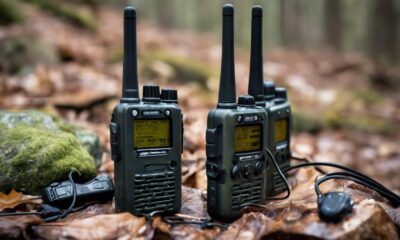
 Coastal Foraging2 weeks ago
Coastal Foraging2 weeks ago15 Best GMRS Radios for Preppers: Stay Prepared and Connected in Any Situation
-

 Coastal Foraging2 weeks ago
Coastal Foraging2 weeks ago15 Best Foods for Preppers to Stock Up on Now
-
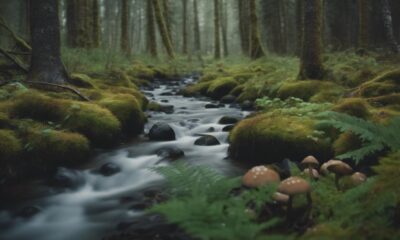
 How to Forage2 weeks ago
How to Forage2 weeks agoUnlock Nature’s Bounty: How to Forage in Alaska Like a Pro!
-

 Spearfishing2 weeks ago
Spearfishing2 weeks agoTraveling with Spear Gear 101: Essential why Tips
-

 Survivalism2 weeks ago
Survivalism2 weeks agoPreppers Netflix: Top Shows to Watch for Survival Tips!
-

 Coastal Foraging2 weeks ago
Coastal Foraging2 weeks agoCalifornia Kelp Identification: A Seaside Guide
-

 Foraging Guides1 week ago
Foraging Guides1 week agoCan You Eat Forage Turnips? Uncover the Edible Secrets!
-

 Foraging Guides2 weeks ago
Foraging Guides2 weeks agoJune Foraging Secrets: Find the Best Wild Foods of Early Summer!















